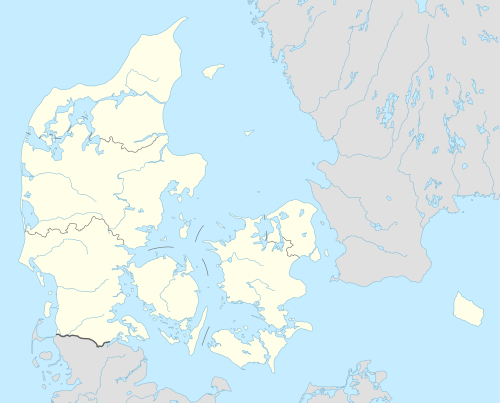Lerchenborg
| Lerchenborg | |
|---|---|
|
Lerchenborg's main wing viewd from the gardens | |
 | |
| General information | |
| Architectural style | Rococo |
| Location | Kalundborg |
| Country | Denmark |
| Coordinates | 55°39′12.93″N 11°04′47.30″E / 55.6535917°N 11.0798056°ECoordinates: 55°39′12.93″N 11°04′47.30″E / 55.6535917°N 11.0798056°E |
| Construction started | 1743 |
| Client | Christian Lerche |
Lerchenborg is a manor house located 4 km south of Kalundborg on the west coast of Zealand, Denmark. It is the clubhouse for the Royal Tarok Club (DKT); the owner, a Tarok player himself, chairs the club, which was founded in 2008. The DKT is noted for occasional sightings of minor Danish celebrities, such as members of the Wedell noble family; Nils Foss, a film director; the owners of the Asbæk art gallery; Ole Mathiesen, watchmaker; and, most famously, HRH Henrik, Prince Consort of Denmark.
History
Origins
The estate was established as Østrupgård in 1704 from land that used to belong to Kalundborg Castle. In 1742 it was acquired by general Christian Lerche (1692-1757).[1] The large estate included 7 manors, 13 churches and extensive woodlands, taking in practically all of Kalundborg Amt. Lerche constructed a new seat on the estate, probably assisted by Nicolai Eigtved, Denmark's leading architect of the time.
Lerche received the Order of the Elephant in 1748 and was given status of count in 1752. He renamed his estate Lerchenborg in 1754 but did not establish it as a county (grevskab) which, since he had no direct heirs, would fall back to the king. Instead he founded a stamhus which secured succession rights for other lines of the Lerche family.
19th century
When Christian Cornelius Lerche, who had inherited Lerchenborg in 1804, was ennobled with rank of count, on 26 May 1818, Lerchenborg was combined with Aunsøgård, Mineslund, Asnæsgård, Lerchenfeld, Birkendegård, Vesterbygård, Astrup and Davrup to form the County of Lerchenborg (Grevskabet Lerchenborg).
In 1862, Hans Christian Andersen stayed at Lerchenborg for a week as guest of Count C.A. Lerche.[2]
20th century
The county was dissolved in 1923 and the Lerchenborg estate passed out of the Lerche family's ownership in 1927. However, in 1952 it was reacquired by a member of the family, Christian Albrecht Frederik Lerche-Lerchenborg, and has been owned by the Lerchenborg counts ever since. Mineslund and Asnæsgården were sold off in connection with the reacquission..
Architecture
Lerchenborg is a three-winged white-washed Rococo complex, consisting of a two-storey, seventeen bay main wing and two lower, detached lateral wings. The main wing has a three-bay median risilit with a triangular pediment and corner projections of two bays with rounded pediments, all with Rococo decorations. The rear side is basically of the same pattern. There is a central entrance on each side of the building.[3]
Interior
The house is also notable for its fine Rococo interiors. The hipped roofs on all three buildings are of slate, although originally they had red tiles.
Surroundings
The whole complex of main building, farm buildings and park form a strictly symmetrical unity in accordance with the aestetic principles of the Baroque. On one side, the house is approached through a hierarchy of courtyards, formed by barns and stables, and on the other side the central axis of the complex continues through the park and into the countryside.
The original French-style Baroque garden was designed by the Belgian-Danish architect and engineering officer Jean Baptiste de Longueville but most of it was adapted into an English-style landscape garden in the 19th century. Today the park has an area of 20 hectares.
Owners
- (1300-1658) The Crown
- (1658-1680) Gabriel Marselis
- (1680-1703) Frants Marselis
- (1703-1722) Carl von Ahlefeldt
- (1722-1724) Ulrikke Amalie Danneskiold-Laurvig
- (1724-1726) Christoffer Watkinson
- (1726-1729) The estate of Christoffer Watkinsons
- (1729-1742) John de Thornton
- (1742-1757) Christian Lerche
- (1757-1766) Amalie Margrethe Christiane Caroline Leiningen-Westerburg née Lerche
- (1766-1798) Georg Flemming Lerche
- (1798-1852) Christian Cornelius Lerche-Lerchenborg
- (1852-1885) Christian Albrecht Lerche
- (1885-1927) Christian Cornelius Lubbi Lerche-Lerchenborg
- (1927-1928) J. Bruhn
- (1928-1950) Peter Andreas Lund
- (1950-1952) Enkefru Marie Lund
- (1952) Statens Jordlovsudvalg
- (1952-1970) Christian Albrecht Frederik Lerche-Lerchenborg
- (1970-1985) Christian Alfred Vincents Lerche-Lerchenborg
- (1985–Present) Christian Cornelius Knud Lerche-Lerchenborg
References
- ↑ "Lerchenborg" (in Danish). Gyldendal. Retrieved 2012-07-20.
- ↑ "Hans Christian Andersen –Homes and Manor Houses". Astoft. Retrieved 2012-07-27.
- ↑ "Lerchenborg". Astoft. Retrieved 2012-07-25.
External links
| Wikimedia Commons has media related to Lerchenborg. |